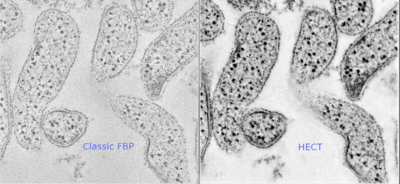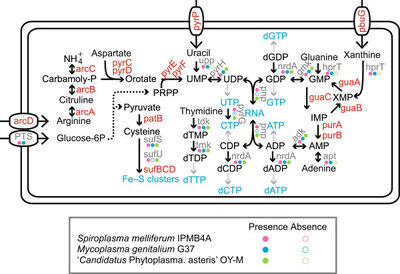Spiroplasma melliferum: Difference between revisions
No edit summary |
|||
| Line 70: | Line 70: | ||
2) Clark, T. B., R. F. Whitcomb, J. G. Tully, C. Mouches, C. Saillard, J. M. Bove, H. Wroblewski, P. Carle, D. L. Rose, R.B. Henegar, and D. L. Williamson. (1985) <B><I>Spiroplasma melliferum</I>, a New Species from the Honeybee <I>(Apis mellifera)</I>. </B>International Journal of Systematic Bacteriology, Vol. 35, No. 3, 296-308. | |||
Edited by Brittany Demmons, student of Dr. Lisa R. Moore, University of Southern Maine, Department of Biological Sciences, http://www.usm.maine.edu/bio | Edited by Brittany Demmons, student of Dr. Lisa R. Moore, University of Southern Maine, Department of Biological Sciences, http://www.usm.maine.edu/bio | ||
Revision as of 20:23, 12 January 2014
A Microbial Biorealm page on Spiroplasma melliferum
Classification
Higher Order Taxa:
Class: Mollicutes
Order: Mycoplasmatales
Family: Spiroplasmataceae
Genus: Spiroplasma
Species: melliferum
NCBI Accession #: JQ347516
Description and Significance
Genome Structure
The whole-genome shotgun sequencing of S. Melliferum IPMB4A produced a draft assembly that was ~1.1 Mb in size and covered ~80% of the chromosome (1).
Cell and Colony Structure
Spiroplasma melliferum is a helical, motile bacteria without cell walls (1). Spiroplasma melliferum has a classic fried-egg shaped colony morphology.
Metabolism
Spiroplasma melliferum ferments glucose and hydrolyzes arginine (1). It also possesses all the genes required for glycolysis to convert glucose-6-phophate into pyruvate which is used for the production of cysteine (1).
Ecology
Endosymbiotic inhabitants.
Pathology
While most of the Spiroplasma species appeared to be harmless commensals of insects, a small number of species have evolved pathogenicity toward various arthropods and plants (1).
Host: infects the honeybee.
References
1) Wen-Sui Lo, Ling-Ling Chen, Wan-Chia Chung, Gail Gasparich, Chih-Horng Kuo. (2013) Comparative genome analysis of Spiroplasma melliferum IPMB4A, a honeybee-associated bacterium. BMC Genomics. 9 January 2014. http://www.biomedcentral.com/1471-2164/14/22
2) Clark, T. B., R. F. Whitcomb, J. G. Tully, C. Mouches, C. Saillard, J. M. Bove, H. Wroblewski, P. Carle, D. L. Rose, R.B. Henegar, and D. L. Williamson. (1985) Spiroplasma melliferum, a New Species from the Honeybee (Apis mellifera). International Journal of Systematic Bacteriology, Vol. 35, No. 3, 296-308.
Edited by Brittany Demmons, student of Dr. Lisa R. Moore, University of Southern Maine, Department of Biological Sciences, http://www.usm.maine.edu/bio



